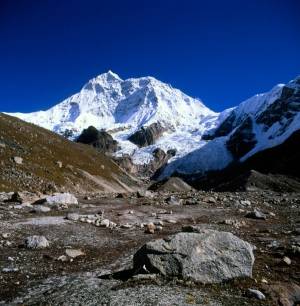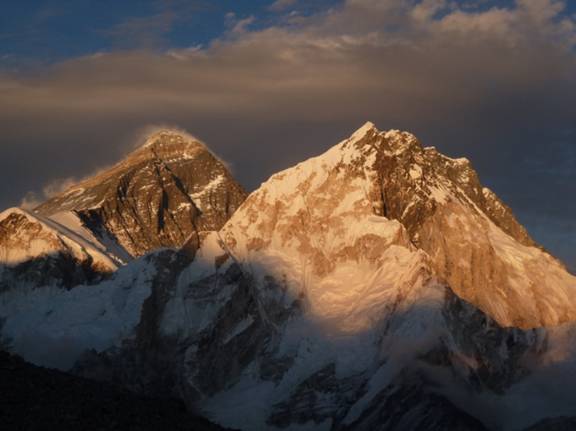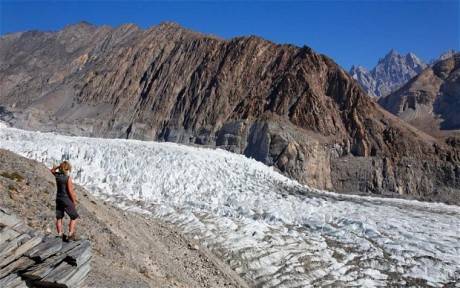The Rapidly Melting Himalayan Glaciers
By Countercurrents.org
24 September, 2012
Countercurrents.org
The Karakoram glacier in the Himalayas
“New research suggests that [the Himalayan glaciers] are rapidly melting […]”, writes Geoffrey Lean, Britain 's longest-serving environmental correspondent, having pioneered reporting on the subject almost 40 years ago. Geoffrey's report of July 27, 2012 headlined “Himalayan glaciers are melting rapidly after all, say scientists” appeared in The Telegraph [1].
Geoffrey's report said:
Remember those infamous Himalayan glaciers? The ones which the Intergovernmental Panel on Climate Change (IPCC's) erroneously predicted would have disappeared by 2035, doing grave damage to the reputation of climate science? New research suggests that they are rapidly melting after all as the world warms up.
[E]arlier this year studies of the glaciers based on satellite data spanning seven years suggested that high-altitude Asian glaciers were losing ice only a tenth as fast as had been previously estimated and that ones on the Tibetan plateau were actually growing.
But the new study – led by professors Lonnie Thompson of Ohio State University and Yao Tandong, director of the Institute of Tibetan Research at the Chinese Academy of Sciences – studied 30 years of data on over 7000 glaciers in the Himalayas and the Tibetan Plateau. They found that about nine per cent of the ice present in the 1970s had shrunk over that period, thought to be a more reliable basis for measuring climate change. And where they had separate data for different decades during that time they found it showed that the melting was accelerating.
“The majority of glaciers have been shrinking rapidly across the studied area in the past 30 years” Professor Yao told Nature Climate Change , the journal that published the study. The scientists expect it to go on accelerating. But, as Prof Thompson rightly pointed out “it is very hard to predict” when a glacier will disappear altogether.

In the Himalayan Mountains , glaciers are retreating more and more rapidly. S. FRASER/SPL
Citing the study by Lonnie, Yao and their colleagues Jane Qiu's report in Nature on July 15, 2012 headlined “Tibetan glaciers shrinking rapidly” [2] said:
The majority of glaciers on the Tibetan plateau and in the surrounding region are retreating rapidly.
The research by Yao Tandong, a glaciologist at the Chinese Academy of Sciences' Institute of Tibetan Research in Beijing, and his colleagues is published in Nature Climate Change [3] “is the most comprehensive survey to date in the region”, says Tobias Bolch, a glaciologist in the University of Zurich, Switzerland .
The Tibetan plateau and the bordering mountain ranges, including the Himalayas, the Karakoram, the Pamir and the Qilian make up a vast region known as the Third Pole, home to 100,000 square kilometers of glaciers that supply water to about 1.4 billion people in Asia.
The status of the glaciers has been a point of contention. Earlier this year, an analysis of 7 years' worth of measurements taken by the Gravity Recovery and Climate Experiment (GRACE) satellite mission suggested [4] that high-altitude Asian glaciers on the whole are losing ice only one-tenth as fast as previously estimated, and that glaciers on the Tibetan plateau are actually growing.
Yao and his colleagues analysed satellite measurements of the lengths and surface areas of about 7,100 glaciers. They also studied changes in the mass balance — the difference between accumulation and loss of ice — of 15 glaciers that they have painstakingly measured for decades.
But embedded in this general trend, says Yao , is a large variation in different parts of the Third Pole. For instance, glaciers in the Himalayas are retreating faster on average than those in the Karakoram and the Pamir .
To unravel the mechanisms underlying this variation, the researchers turned to climate records of the entire region. They found that changes in the glaciers, especially in their mass balance, depend in large part on whether the ice is under the influence of the Indian monsoon or the westerlies, the prevailing winds from Europe .
“Temperature rise is important,” says Yao . “But its effects on glaciers also depend on climate regimes.” In places dominated by the westerlies, such as the Karakoram and the Pamir plateau, glaciers gain their mass mostly from winter snow, and so are less affected by warming because temperatures in winter are still below zero. In the eastern and central Himalayas , however, it snows mainly during monsoon season, and a slight increase in summer temperatures can affect glaciers drastically.
In the past few decades, the Indian monsoon has been getting weaker. By contrast, the westerlies are getting stronger. “This explains why most glaciers that are either stable or advancing are in the Karakoram or the Pamir plateau,” says Yao .
The study raises serious issues with assessments based on GRACE measurements. Some climate scientists say that the measurements were taken over too short a time to capture the impact of climate change. Others question whether the satellite is suited to studying ice changes in the Third Pole.
The Tibetan plateau contains closed catchments where glacier melts can be stored in lakes, the soil and underground. A survey by Yao and his colleagues found that the area of glacial lakes on the plateau has increased by about 26% since the 1970s. “As the GRACE satellites can only feel the gravitational pull and can't tell the difference between ice and liquid water, they may have mistaken expanding glacial lakes for increases in glacier mass,” says Yao .
John Wahr, a remote-sensing expert at the University of Colorado Boulder and lead author of the GRACE study, concedes that the criticism is valid. “This is an important weakness of GRACE for any non-polar glacier study,” he says.
Lonnie Thompson, a glaciologist at Ohio State University in Columbus , and a co-author of the latest paper [said]: “Mass-balance studies are extremely labor intensive and can often be dangerous, but there is never a substitute for boots on the ground.”

Satellites can be powerful tools to map complex changes across large, inaccessible areas — but only if researchers are able to interpret correctly what their measurements mean.
On August 22, 2012 Jane Qiu's article in Nature titled “Himalayan glacier data shift to the middle ground” [5] said:
A 2010 study using measurements taken by the Gravity Recovery and Climate Experiment (GRACE) satellite reported that glaciers in the Himalayas and the Tibetan plateau were shedding roughly 50 gigatonnes of ice a year. But these results were refuted two years later by another group that used the same data set but interpreted it to show that ice loss was only one tenth of that amount.
Now a third study of Himalayan glaciers, using a different satellite called ICESat, indicates that these glaciers lost an average of 12 gigatonnes ice a year between 2003 and 2008. The work is published today in Nature .
The new estimate raises further questions about satellite and field measurements of alpine glaciers, and ”will set the cat among the pigeons,” says Graham Cogley, a remote-sensing expert at Trent University in Peterborough, Ontario, [6]. Although the ICESat results show twice as much ice loss as the re-interpreted GRACE data, this figure is still three times lower than regional losses estimated on the basis of field studies. ICESat was launched by NASA in 2003 to track changes in polar ice sheets by measuring their surface elevations with a laser altimeter. “It was designed for smooth topography of the polar regions and cannot be readily used to map rough terrains such as the Himalayas ,” says Andreas Kääb, a remote-sensing expert in the University of Oslo in Norway , who led the latest study.
To get around this problem, the team systematically corrected the ICESat data using elevation measurements from the Shuttle Radar Topography Mission, an international research effort to generate a high-resolution digital topographic database of Earth.
Kääb and his colleagues also checked the altitude of the adjacent terrain, which should not change over a short period of time, to make sure that any changes in elevation detected by ICESat in the glacier surface are genuine. Once these corrections and checks were in place, the researchers used the ICESat data to map the region at a resolution of up to 70 meters. Their study shows that, between 2003 and 2008, Himalayan glaciers thinned at a rate of about 21 centimeters a year on average, significantly less than the estimated global average for glaciers and ice caps.
Kääb warns, however, that the average ice change can be misleading because it conceals large glacier losses in some parts of the Himalayas that are balanced out by smaller changes, or even gains, in others. In northwestern India , for example, glaciers thinned by about 66 centimeters a year, whereas those in the Karakoram on the whole changed little.
Such regional variations “matter a lot for the millions of people living in river basins that are fed by those glaciers”, says Kääb.
“The study is the first regionally complete measurement [of Himalayan glaciers] that is in general agreement with individual field studies,” says Cogley. He points out, however, that discrepancies with other satellite studies and regional-scale field assessments remain. “We need to keep an open mind” about different satellite methods and the fate of Himalayan glaciers, he adds.
Kääb stresses that the study, like the GRACE observations, does not indicate the climate trend or the fate of the Himalayan glaciers, which would require data collected across several decades. “We are merely pointing to a new way to use ICESat, and the results can be used as a baseline for future studies,” he says.
To Lonnie Thompson, a glaciologist at Ohio State University in Columbus , there is an urgent need to understand why these satellite studies differ from each other and from some field measurements, what their sources of errors are, and how they can be better calibrated. “This is the only way to track changes in the 46,000 or so glaciers in the Himalayas and the Tibetan plateau,” he says.
Source / Reference :
[2] Nature , doi:10.1038/nature.2012.11010,
http://www.nature.com/news/tibetan-glaciers-shrinking-rapidly-1.11010
[3] Yao , T., et al. Nature Climate Change http://dx.doi.org/10.1038/NCLIMATE1580 (2012).
[4] Jacob, T., Wahr, J., Pfeffer, W. T. & Swenson, S., Nature 482, 514–518 (2012).
[5] Nature , doi:10.1038/nature.2012.11252
http://www.nature.com/news/himalayan-glacier-data-shift-to-the-middle-ground-1.11252
[6] Cogley, G. Nature ,488, 468–469 (2012)
Bolch, T. et al. Science ,336, 310–314 (2012)
Kääb, A., Berthier, E., Nuth, C., Gardelle, J. & Arnaud, Y. Nature 488, 495–498 (2012)
Matsuo, K. & Heki, K. Earth Planet. Sci. Lett ., 290, 30–16 (2010)
Comments are moderated



